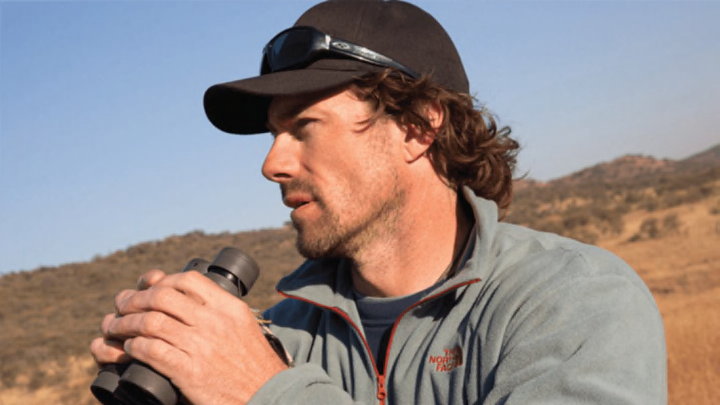Professional cat handler Boone Smith spends his days catching the biggest felines in the world for our safety—and theirs.
My grandpa was a bounty hunter. In the 1960s, there was a bounty on mountain lions and bears. When there were problems with mountain lions, people would call him to catch them. It wasn’t uncommon to have a mountain lion in the chicken coop, so we were involved from the time we were kids.
Hounds were part of our lives. It was exciting to go out with Dad and Grandpa and let the hounds go, watching them send a mountain lion jumping up a tree. I thought, “I want to be like Dad and Grandpa,” never thinking that’s what I would actually do.
I focused on wildlife biology. I don’t know if you can call it dumb luck, but through networking I got a job as a biologist on a cougar-wolf interaction study. I knew how to catch the cats. The next thing I knew, people were calling from all over the world asking me to catch cats for them.
Mountain lions are probably what I catch the most, and the most effective way is to use dogs. We take advantage of the age-old dog-hates-cat relationship. Dogs pick up the scent and make a lot of noise, the cat hears it, and its instinct is to climb a tree. From there, we tranquilize the cat.
For a long time, animal handling was pretty rough-and-tumble, but we work to do it better. We make sure the cat doesn’t fall. I climb up the tree and rope it up; we give it a sedative; we collar it and take blood samples. Keeping the animal—and ourselves—safe is the most important part.
In the summer I do a lot of training, teaching my dogs new tricks. It’s when I travel to the Southern Hemisphere for different projects. In Brazil, we snag jaguars at night in order to control their temperature a little. Heat is rough on big cats; even in winter, the biggest problem is keeping them from overheating. Winter gets busy. I start doing re-collars, catching mountain lions. You’re up before the sun, looking for tracks, getting the dog where it can catch a scent. It’s a lot of hiking.
All my scars are from kittens, and I suppose that’s good. That doesn’t mean there haven’t been close calls. It’s the nature of the job. A lot of it is common sense, as crazy as it sounds, and a gut feeling of when I can push and being willing to walk away.
Mountain lion kittens are about the cutest thing on the planet, just little fuzzballs. They have big blue eyes that eventually turn yellow. They’re cute, so you let your guard down. But they hiss and snarl, and their claws are needle-sharp. That’s what leaves the marks. We do den work, marking kittens for studies. Den work is some of the most fun stuff I’ve ever done.
We’ve documented 15 different vocalizations of cougars. We’ve heard combinations of chirps and yips and yells. Cougars, snow leopards, and jaguars are all solitary, but on camera we see these cats interact. They’re more social than we realize.
We’re also looking at how cats adjust to humans. Sometimes we find mountain lions right in the middle of neighborhoods, and people are clueless. It’s cool to see how they figure out our habits and routines and conform their lives around that.
Even tamed domestic cats have the wild instinct. If you turn your house cat loose, it’s going to hunt. This is true from a tabby to a Siberian tiger.
The cool thing about cats is their personalities. You can’t chalk it up to anything except that it’s this cat. Some are bullies; some are playful.
More tigers are in captivity than in the wild. Lions and tigers define so many different things for people, and they’re disappearing. Fifty years ago, lions numbered in the hundreds of thousands; today we have something like 32,000. We want to create awareness so we’re not trying to save the last 50 of any animal.
